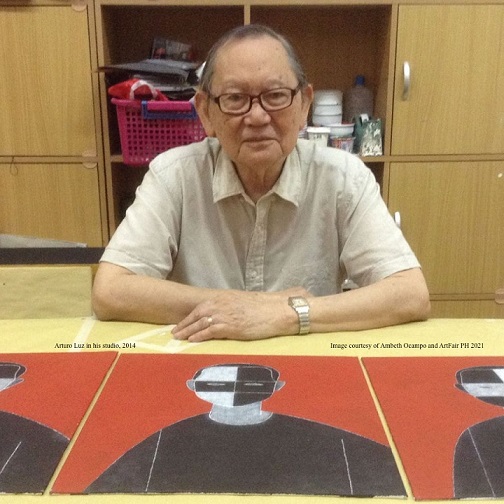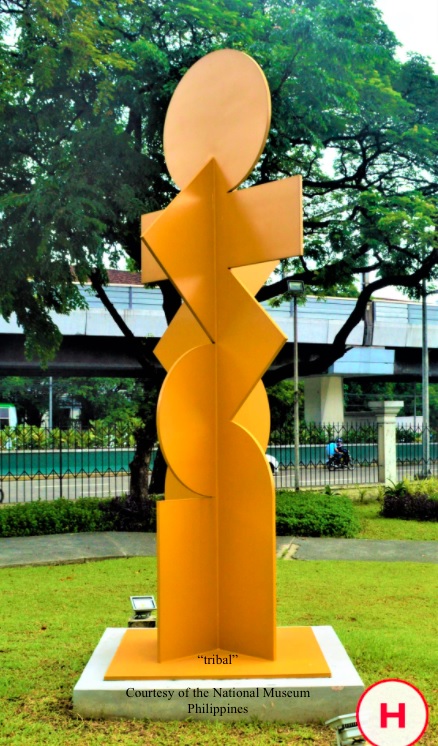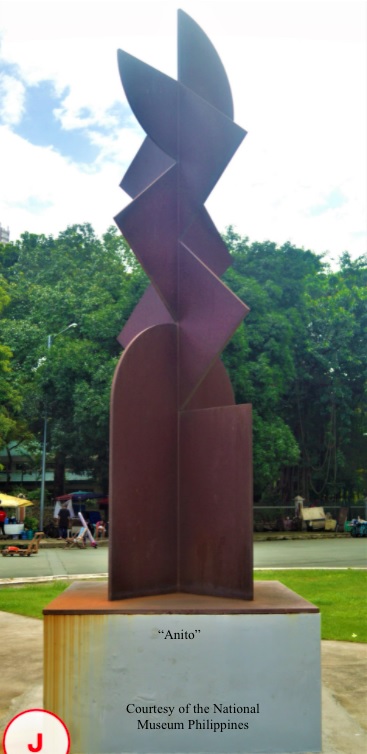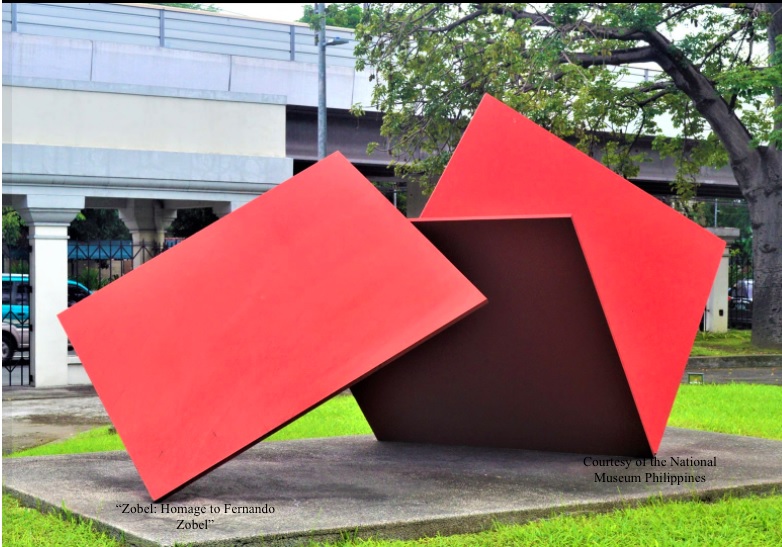
Arturo Luz in his studio, 2014. Photo courtesy of Ambeth Ocampo and ArtFairPH/Talks 2021.
Four persons who have known Arturo Luz (1926-2021) through the years shared their sweet thoughts and memories of the artist who passed away recently. Arturo Luz: Personal Views celebrates the life of Arturo Luz through four of his closest friends. (see YouTube, ArtFairPH/Talks 2021)
Boots Herrera, curator of Ateneo Art Gallery, introduced Luz as “the last among that generation of post-war modernists who helped define the trajectories, configurations and abstractions of Philippine art.”
A funny and witty man, Luz likes to boast playfully that he is the only artist who can draw a straight line, of course, with the help of a ruler, quips historian Ambeth Ocampo. He reveals that Luz had different signature styles to correspond with the date of his work, so he would know its veracity.
For Andy Locsin, it was an organic unfolding of Luz as a warm and straightforward man. Luz was a very close friend of his father, the architect Leandro Locsin. Andy marvels at their absolute trust and faith in each other’s work. Their conversations always revolved on taste and restraint. Taste in the sense of what is appropriate, what goes with what, and knowing when to stop.
Tina Bonoan, an architect and product designer, was flabbergasted with the austerity of Luz’s office. No clutter, only the essentials, a wooden desk, Mies van der Rohe chairs, and bare walls. Luz was “the epitome of impeccable taste, a master of proportion and balance, and he puts things together like no other.”
Ocampo adds that Luz trained a whole generation of curators and art managers to be professional through the government institutions under his watch.
Malu Gamboa had asked Luz in 1995 to do collages of traje de luces or used matador costumes from Madrid as part of the design of El Cirkulo restaurant. Luz made 11 torero collages that still hang in the restaurant to this day. They were exhibited at the UP Vargas Museum in 2007 and the National Museum in 2019.
She adds that everything about him was precise. “The right use of words, the straightness of his lines, his work ethics.” He would start a sentence with “Listen” and end it with “That’s it.” They would also go ballroom dancing and Luz would dance the night away. He opened a new door for her, and she fell in love with Filipino art and artists.
Luz works seven days a week. In a 2015 interview, he asserted, “my life is to paint. Because I keep working, I could give any show, any day of the week.”

Tribal. Photo courtesy of the National Museum Philippines.
Constancy in modernism
In an artistic career spanning 60 years, Arturo Luz started with figurative works and explored other forms of abstraction and stylized figuration, often using black, white, red, and ochre. Eventually, he concentrated on abstract work, linear and geometric.
He describes his journey to abstraction in the 1960s: “Everything has been reduced to a flat, two-color, three-tone arrangement, achieving extreme simplification.”
In celebration of the artist’s 90th birth anniversary, Ateneo Art Gallery and Ayala Museum honored him with an exhibition. #LUZ@90 by Ateneo Art Gallery in 2016 and Arturo Luz: First Light by Ayala Museum in 2017 and remounted as a virtual exhibition in 2020. Ambeth Ocampo curated both exhibitions.
The early years
In 1952, Arturo Luz created a series of paintings that depict ordinary Philippine life: street musicians, children playing, and vendors.
Candle Vendors (1952-1954) shows three women, with elongated brown bodies, almost blank faces, and muted colors. In Bagong Taon (1952), three stick-like figures are all riding a single bicycle. Harana in Manila (1955), depicts a group of serenaders, with slim lines. Engraved in Steuben crystal, it is most probably the only work of Luz in this medium.
Together with four artists who would all become National Artists, Luz also took part in the design of the UP Catholic Chapel with his floor mosaics radiating from the altar, entitled The Rivers of Life.
Sculptures
Some metal sculptures made by Luz are in the National Museum complex, all geometrical forms in different finishes.
His Anito is the largest and its rust finish left intentionally to the elements. Other Anito sculptures are in the Batasang Pambansa complex and the Philippine International Convention Center.

Anito. Photo courtesy of the National Museum Philippines.
Background
Luz earned a diploma in art from the California College of Arts and Crafts in 1949. Further studies led him to the Art School of Brooklyn Museum, New York, Académie de la Grande Chaumière, Paris, and Instituto Cultura Hispanica, Madrid.
He headed three government institutions concurrently in the 1970s-1980s: Metropolitan Museum of Manila, Design Center of the Philippines, and the now defunct Museum of Philippine Art. He was also the founder and owner of the prestigious Luz Gallery (1960-1973).
He received the highest award given to Filipino artists, the National Artist for Visual Arts in 1997. Other awards include the Republic Cultural Heritage Award, 1966, the French government’s Chevalier of the Order of Arts and Letters in 1978, promoted to Official in 1980, and Gawad CCP Para sa Sining, Cultural Center of the Philippines, 1989.

Zobel: Homage to Fernando Zobel. Photo courtesy of the National Museum Philippines.